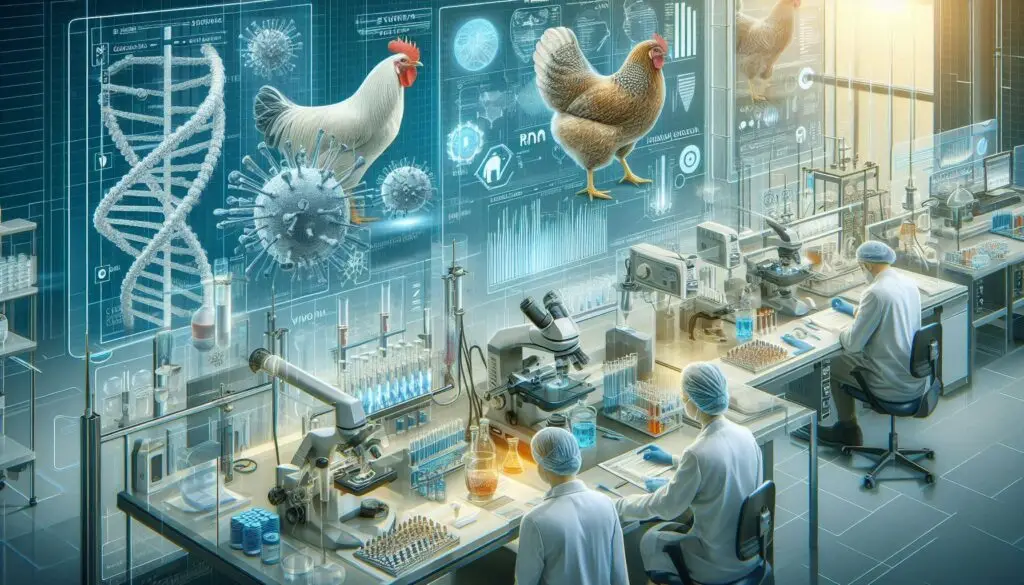Poultry Vaccine Production Strategies

Strategies for Effective Vaccine Production in Poultry Birds
Poultry farming plays a crucial role in global food production. Effective vaccination is essential to prevent infectious diseases and ensure flock health. This article explores key strategies in vaccine production for poultry birds.
Understanding Poultry Vaccines
Vaccines stimulate the immune system to develop resistance against pathogens. Poultry vaccines come in different forms, including live attenuated, inactivated, recombinant, and subunit vaccines.
Read more about poultry immunization here.
Selecting the Right Vaccine Type
Live Attenuated Vaccines
Live vaccines contain weakened pathogens that trigger an immune response without causing disease. They are effective but require careful handling.
Inactivated (Killed) Vaccines
These vaccines use dead pathogens. They are safer but require adjuvants to enhance immunity. Explore inactivated vaccine development.
Recombinant Vaccines
These vaccines use genetic engineering to create safer and more effective solutions. They eliminate the risks associated with live pathogens.
Subunit Vaccines
They use specific pathogen proteins to stimulate immunity. They are ideal for farms aiming for high safety standards.
Antigen Production and Purification
Culturing Pathogens
Antigens are produced by cultivating pathogens in controlled environments such as embryonated eggs or bioreactors.
Purification Process
The antigen undergoes purification to remove impurities while retaining immunogenicity. Learn about antigen purification techniques.
Role of Adjuvants and Stabilizers
Adjuvants enhance immune response, while stabilizers ensure vaccine potency.
Common Adjuvants Used
- Aluminum hydroxide
- Oil emulsions
- Saponins
Essential Stabilizers
- Sucrose
- Skim milk
- Gelatin
Effective Vaccine Delivery Methods
Mass Vaccination Techniques
Drinking Water Vaccination – Live vaccines can be administered via drinking water. This method is cost-effective and practical for large flocks.
Spray Vaccination – This is ideal for respiratory diseases like Infectious Bronchitis. See proper spray vaccination techniques.
Feed-Based Vaccination – Some vaccines can be mixed with poultry feed, ensuring easy administration.
Individual Bird Vaccination Methods
Injection (Subcutaneous or Intramuscular) – Common for inactivated vaccines, providing long-term immunity.
Eye Drop/Nasal Drop – Often used for respiratory vaccines, ensuring precise dosage.
Quality Control & Safety Testing
Quality control ensures that vaccines are safe and effective before reaching poultry farms.
Key Testing Procedures
- Batch Testing – Ensures sterility and potency.
- Challenge Trials – Compares vaccinated and unvaccinated birds.
- Adverse Reaction Monitoring – Identifies side effects to maintain safety standards.
Understand vaccine safety regulations.
Cold Chain Management & Storage
Maintaining an optimal temperature is crucial for preserving vaccine efficacy.
Temperature Guidelines
- Live vaccines: -20°C
- Inactivated vaccines: 2-8°C
Lyophilization (Freeze-Drying)
Some vaccines undergo freeze-drying to extend shelf life. Read about cold chain management.
Advances in Poultry Vaccine Production
Genetic and Molecular Technologies
mRNA and Vector-Based Vaccines – These methods are gaining popularity due to their precision and quick development time.
CRISPR and Synthetic Biology – Scientists are using gene-editing tools to create highly effective vaccines with improved safety.
Disease Surveillance for Custom Vaccines
Regular monitoring of disease outbreaks enables the development of farm-specific vaccines. Find disease surveillance tools.
Conclusion
Effective vaccine production in poultry birds requires careful planning, advanced technology, and rigorous quality control. By adopting these strategies, poultry farmers can protect their flocks from infectious diseases, ensuring productivity and profitability.
For more pearls of Vets Wisdom:






Responses